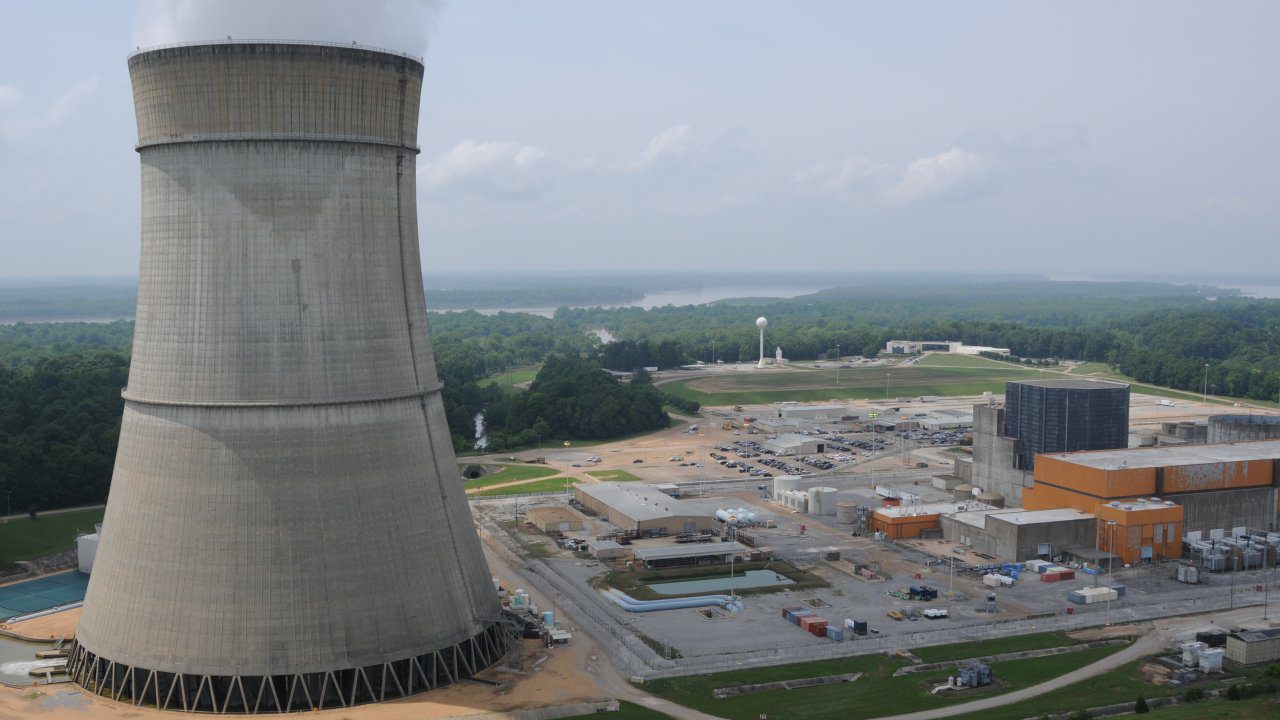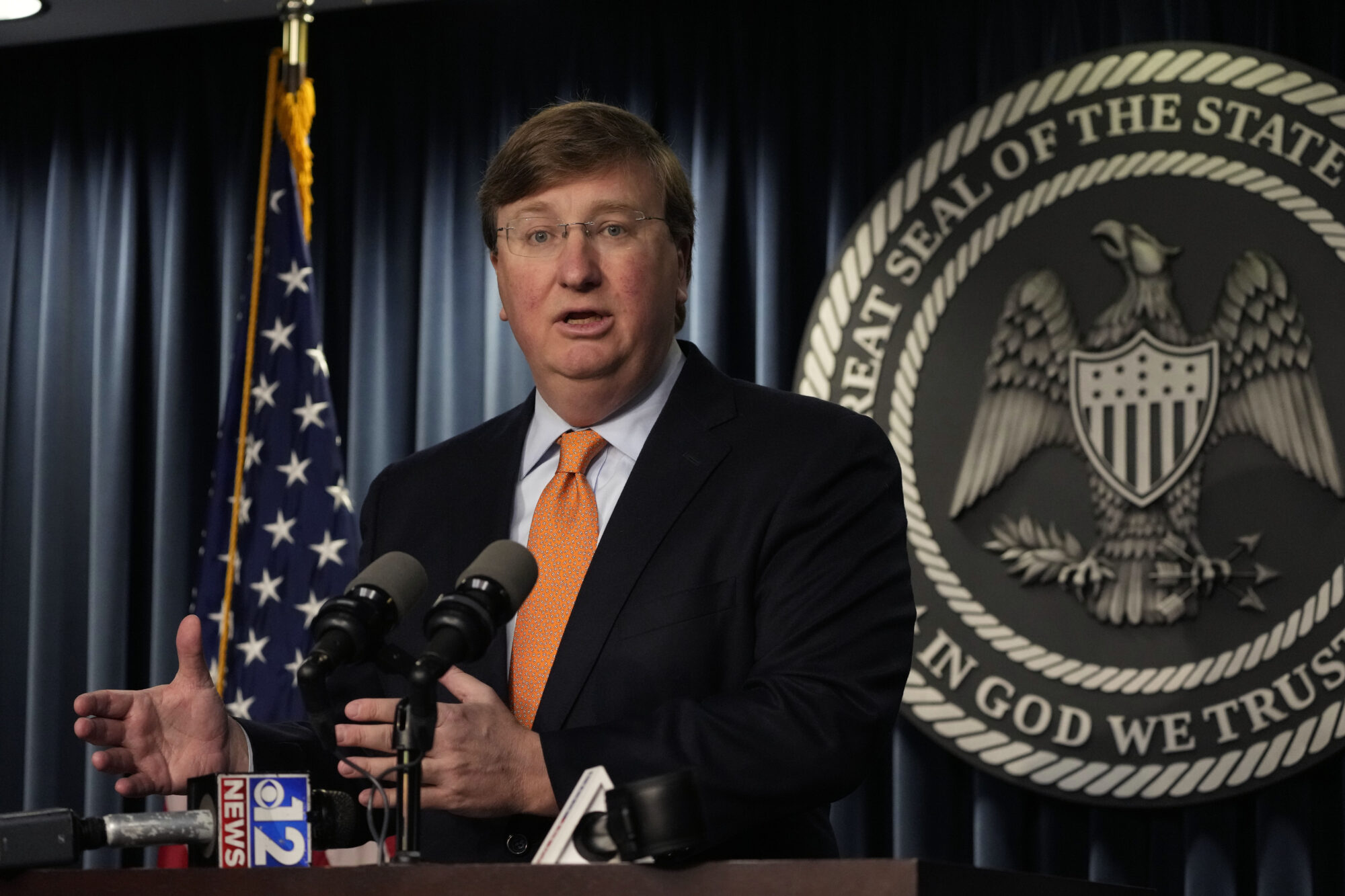
Grand Gulf Nuclear Station in Port Gibson, Miss. (Photo from Entergy)
- The Public Service Commission held a Nuclear Summit this week. New technologies are being developed. The future for more nuclear power in Mississippi is on the table.
Nuclear power is seeing a resurgence in popularity as policy leaders consider potential clean energy sources to meet the growing demand across the nation and in the state of Mississippi.
Mississippi’s current nuclear power footprint
The Mississippi Public Service Commission held a Nuclear Energy Summit Tuesday to hear about the potential for more nuclear energy generation in the state other than the one already in operation.
During the meeting Northern Commissioner Chris Brown (R), Central Commissioner De’Keither Stamps (D), and Southern Commissioner Wayne Carr (R) heard from a variety of professionals in the field of nuclear energy.

Commissioner Brown stated that the meeting was held in response to Mississippi’s growing energy needs, citing the anticipated construction of the Amazon data centers as just one of several large projects coming to the state. Data centers have high electricity demands due to the large number of servers.
Mississippi’s lone nuclear power plant is operated by Entergy in Port Gibson. Known as the Grand Gulf Nuclear Station, the plant is one of five nuclear power plants operated by Entergy in the United States, Jim Smiley, Entergy’s Senior Manager of Advanced Nuclear Development said. The other four are operating in neighboring Louisiana and Arkansas, with two in each state.
Mississippi’s nuclear plant has been in operation since 1985 and received an upgrade to its power generation capability in 2012, making it stand out among other nuclear power plants in the world.
“Right now, it’s the largest single unit operating nuclear reactor in the country and actually is the 11th largest in the world,” Smiley described.
The plant is capable of generating 1,433 megawatts of power, enough to provide electricity to about 856,000 homes.
Nuclear power generation is more economical than traditional generation methods, Commissioners were told. Smiley said one uranium pellet used in the generation of power by a plant is about the size of a pencil eraser. That one pellet has the same potential for electricity generation as ton of coal, 149 gallons of oil, or 17,000 cubic feet of natural gas.
Nuclear power plants may seem complex, but Smiley described them simply.
“When we talk about nuclear power, nuclear is the heat source. So instead of burning coal, instead of burning gas, it’s the heat source that we use to boil water, turn turbines, generate electricity,” Smiley elaborated. “And this represents very simplistically what Grand Gulf is, it’s a boiling water reactor which means we generate heat from the reactor vessel, boil water and send it to the turbines.”
Clouds seen coming from the top of nuclear power plant cooling towers are water vapor generated as part of the process and are therefore not harmful, he added.
Most nuclear power plants are capable of operating for roughly 80 years. Grand Gulf is currently licensed to operate until 2044, and the option remains to extend it by another 20 years, Smiley said.
Entergy is considering construction of another nuclear power plant at the same site, but the company is waiting for new technology to prove itself in order to avoid taking unnecessary financial risks.
Smiley added none of the proposed newer systems have actually been built and tested as of yet.
Removing hurdles from nuclear power generation
One of the hurdles of building new nuclear power generation sites is the timely and expensive process through the United States Nuclear Regulatory Commission. That is what Congress’ recently passed Accelerating Deployment of Versatile Advanced Nuclear for Clean Energy (ADVANCE) Act is designed to address.
Mike King, Special Assistant for ADVANCE Act Implementation with the United States Nuclear Regulatory Commission, described how the measure aims to minimize barriers in an effort to boost electricity generation through more nuclear power plants.
The ADVANCE Act mandates the NRC modify its mission statement and policies to be more efficient in the license application process, cut fees for advance reactor applications and pre-applications, and ensure applications are not forgotten on an employee’s desk while awaiting further action.
King added that all signs point to growth in the nuclear energy industry.
“I think the latest estimate I’ve heard is by 2050 adding potentially 200 additional giga watts of nuclear generation capacity,” King described.
To meet that goal, power companies across the country would need to build 74 plants similar in size to Grand Gulf.
Currently, the United States has the most nuclear plants in operation worldwide at 94, with France and China close behind with 56 each. Jeffrey Merrifield with Pillsbury Winthrop Shaw Pittman LLP, an international law firm with a particular focus on the technology & life sciences, energy, financial, and real estate & construction sectors, said China is well on its way to becoming the leading producer of nuclear energy with 17 additional facilities currently under construction.
Nuclear energy generation and its risks
While all of the speakers at the PSC Nuclear Summit spoke favorably about nuclear energy, touting its cost savings once operational and providing a level of reliability solar and wind energy generation cannot match, nuclear energy comes with some risks.
Meltdowns are one of the most significant incidents that can occur at nuclear power sites.
While fatal accidents have occurred at experimental reactors, most incidents at commercial reactors do not result in death and/or contamination of the environment, according to the World Nuclear Association. In a report published by the agency in August, only three significant commercial plant meltdowns have occurred during the six decades nuclear power plants have been in use worldwide – the Fukushima Daiichi plant in Japan in 2011, the 1986 Chernobyl incident in Ukraine, and the incident at Three Mile Island in 1979.
No deaths were reported as a direct result of the meltdowns at Three Mile Island and Fukushima, but several deaths were attributed to the incident in Chernobyl. That incident resulted in the initial deaths of two people, with another 28 dying due to radiation exposure, the report states.
While those incidents are concerning, the World Nuclear Association report points out that meltdowns or other accidents at commercial nuclear power plants are relatively rare considering they have been in operation for so long across more than 35 countries, equating to a total run time of 18,500 reactor-years.
“Of all the accidents and incidents, only the Chernobyl and Fukushima accidents resulted in radiation doses to the public greater than those resulting from the exposure to natural sources,” the report cites. “Apart from Chernobyl, no nuclear workers or members of the public have ever died as a result of exposure to radiation due to a commercial nuclear reactor incident.”
Future of nuclear power generation
Members of the Commission also heard about emerging technology that can make nuclear power generation more portable and more efficient.
James Walker, CEO of Nano Nuclear Energy, spoke on the portability of the microreactors his company is designing. While they are still in the prototype phase, he is confident the microreactors, which typically put out 5 megawatts of thermal energy or 1 megawatt of electricity, can meet the needs of communities worldwide currently relying on diesel generators.
Target areas are island communities, disaster relief areas, military bases, marine vessels and mining projects, but Walker added that the reactors could work in a variety of other applications.
“Essentially, there are hundreds of thousands of opportunities here, if not millions, because these actually will open up a lot of economic potential around the world,” Walker said.
The company is developing small generators that can be transported quickly by rail or truck and be operational in a very short time.
A major concern for the future, however, is the current presidential administration’s ban on the importation of enriched uranium products from Russia. While the ban allows the purchase of uranium through a waiver process until 2028, it has led to the federal government sending $2.72 billion to the Department of Energy for investment in more domestic uranium enrichment facilities.
“The Russian Federation has also proven by its actions it is willing to weaponize economic relationships, which makes the continued reliance on Russian uranium products a threat to U.S. energy and economic security through dependence on an insecure source or supply of uranium needed for domestic nuclear energy,” according to the U.S. Department of State in a statement issued in May on the passage of H.R. 1042, otherwise known as the Prohibiting Russian Uranium Imports Act.
The now limited access to uranium from Russia and the need to transport nuclear fuel to plants across the nation have caused Walker’s company to work to develop methods to not only produce uranium stateside but also purchase rights to technology that can be used to safely transport nuclear fuel.
Other technologies under development that could help with limited access to domestic nuclear fuel include ways to recycle spent fuel rods. Walker described how uranium’s energy density leads to only one percent of the fuel being expended during the life of the reactor.
“So, if you can recover that other 99 percent of the fuel, you got another reactor,” Walker added.
Currently in the United States, there is an inability to reprocess the material, but Walker hopes the ADVANCE Act will lead to changes.
“But that might actually change,” Walker noted. “And if they change it, we could actually recover (it). There’s huge amounts of nuclear fuel that could power the states for hundreds of years, in spent fuel that currently exists.”
Another new technology proposed for nuclear power generation involves the use of lithium fluoride reactors. Kirk Sorensen, founder and president of Flibe Energy, described to the Commission how his company is using old technology that employs a coolant comprised of liquid salt that can reach higher temperatures without boiling, meaning less pressure in nuclear power plant cooling systems.
“Salt is the only coolant we have that is going to go to very high temperatures while still operating at low pressure,” Sorensen said.
That process, combined with the use of thorium instead of uranium, can create reactors that are not only more efficient, but are designed to recycle the uranium created as a byproduct of thorium’s reaction process.
Sorenson told the Mississippi Commissioners that the technology was developed in the 1950s and demonstrated back in the 1960s. It was shelved because the process did not align with the nation’s nuclear ambitions.
You can watch the full PSC Nuclear Summit below.










